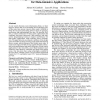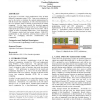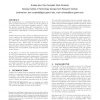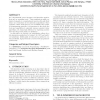119
Voted
ASPLOS
2009
ACM
15 years 4 months ago
2009
ACM
As our society becomes more information-driven, we have begun to amass data at an astounding and accelerating rate. At the same time, power concerns have made it difficult to brin...
108
Voted
ASPLOS
2009
ACM
15 years 4 months ago
2009
ACM
Software systems are constantly changing. Patches to fix bugs and patches to add features are all too common. Every change risks breaking a previously working system. Hence admini...
119
click to vote
ASPLOS
2009
ACM
15 years 4 months ago
2009
ACM
Optical Quadrature Microscopy (OQM) is a process which uses phase data to capture information about the sample being studied. OQM is part of an imaging framework developed by the ...
121
Voted
ASPLOS
2009
ACM
15 years 7 months ago
2009
ACM
This paper presents a performance analysis of an accelerated 2-D rigid image registration implementation that employs the Compute Unified Device Architecture (CUDA) programming e...
103
Voted
ASPLOS
2009
ACM
15 years 7 months ago
2009
ACM
This paper explores the architectural implications of integrating computation and molecular probes to form nanoscale sensor processors (nSP). We show how nSPs may enable new compu...
104
Voted
ASPLOS
2009
ACM
15 years 7 months ago
2009
ACM
We describe a strategy for enabling existing commodity operating systems to recover from unexpected run-time errors in nearly any part of the kernel, including core kernel compone...
179
Voted
ASPLOS
2009
ACM
16 years 1 months ago
2009
ACM
196
Voted
ASPLOS
2009
ACM
16 years 1 months ago
2009
ACM
In this paper we describe a GPU parallelization of the 3D finite difference computation using CUDA. Data access redundancy is used as the metric to determine the optimal implement...
227
Voted
ASPLOS
2009
ACM
16 years 1 months ago
2009
ACM
QR decomposition is a computationally intensive linear algebra operation that factors a matrix A into the product of a unitary matrix Q and upper triangular matrix R. Adaptive sys...
191
Voted
ASPLOS
2009
ACM
16 years 1 months ago
2009
ACM
As computational power increases, tele-immersive applications are an emerging trend. These applications make extensive demands on computational resources through their heavy use o...




